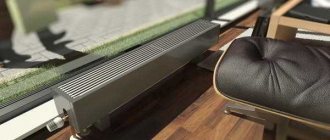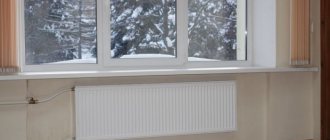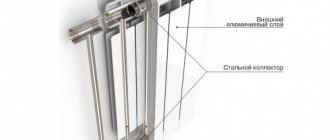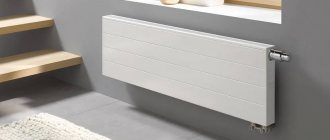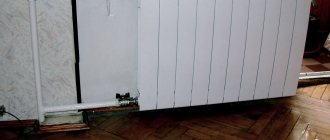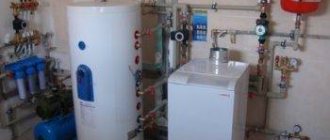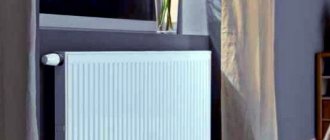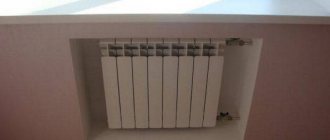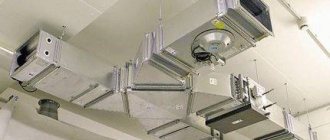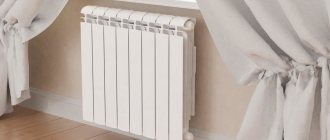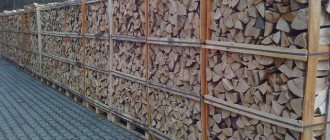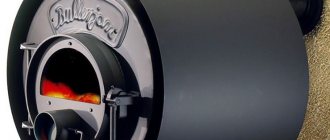The heating problem in our latitudes is much more acute than in Europe with its mild climate and warm winters. In Russia, a significant part of the territory is under the rule of winter for up to 9 months a year. Therefore, it is very important to pay sufficient attention to the selection of heating systems and calculation of the power of heating radiators.
Unlike underfloor heating, where only the area is taken into account, the power of heating radiators is calculated according to a different scheme. In this case, you should also take into account the height of the ceilings, that is, the total volume of the room in which it is planned to install or replace the heating system. There is no need to be afraid. Ultimately, the entire calculation is based on elementary formulas, which will not be difficult to master. Radiators will heat the room thanks to convection, that is, air circulation in the room. Heated air rises and displaces cold air. In this article you will get the simplest calculation of the power of heating radiators.
An example of calculating the power of heating batteries
Let's take a room with an area of 15 square meters and a ceiling height of 3 meters. The volume of air to be heated in the heating system will be:
V = 15 × 3 = 45 cubic meters
. Next, we calculate the power that will be required to heat a room of a given volume. In our case - 45 cubic meters. To do this, you need to multiply the volume of the room by the power required to heat one cubic meter of air in a given region. For Asia and the Caucasus it is 45 watts, for the middle zone 50 watts, for the north about 60 watts. As an example, let's take a power of 45 W and then we get:
45×45=2025 W - power required to heat a room with a cubic capacity of 45 meters
How to adjust preliminary indicators
Approximate values definitely need clarification. To obtain a more accurate result, you will need to take into account all factors.
Each of them can provoke an increase or decrease in heat loss:
- Material for walls.
- Thermal insulation efficiency.
- Area of window units and type of glazing.
- Number of external walls.
High-quality calculators are equipped with special coefficients that take these factors into account. All that is required to more accurately align the preliminary heat loss indicators is to multiply them by these coefficients.
Selecting a radiator based on calculation
Steel radiators
Let's leave the comparison of heating radiators out of the picture and note only the nuances that you need to have an idea about when choosing a radiator for your heating system.
In the case of calculating the power of steel heating radiators, everything is simple. There is the necessary power for an already known room - 2025 watts. We look at the table and look for steel batteries that produce the required number of watts. Such tables are easy to find on the websites of manufacturers and sellers of similar products. Pay attention to the temperature conditions at which the heating system will be operated. It is optimal to use the battery in 70/50 C mode.
The table indicates the type of radiator. Let's take type 22 as one of the most popular and quite worthy in terms of its consumer qualities. A 600x1400 radiator is perfect. The power of the heating radiator will be 2015 W. It's better to take a little extra.
Aluminum and bimetallic radiators
Aluminum and bimetallic radiators are often sold in sections.
Capacity in tables and catalogs is indicated for one section. It is necessary to divide the power required to heat a given room by the power of one section of such a radiator, for example: 2025/150 = 14 (rounded to whole numbers)
We have obtained the required number of sections for a room with a volume of 45 cubic meters.
Coating process
Initially, it turned out that domestic heating radiators look a little rough and old-fashioned, but if you properly treat the surface and choose an interesting design, the devices will please the eye for a long time. The following instructions will help you carry out the work without professional help.
General provisions
First, preliminary recommendations should be considered to ensure a high-quality coating application, after which one should proceed to study the sequence of actions.
As for tools, you will need a simple painting kit for the work.
Painting: a – use a brush, b – use a special spray can.
- As the main equipment, it is recommended to use a small smooth roller made of foam rubber and a brush necessary for treating hard-to-reach places. If necessary, the battery can be removed to provide access to certain areas.
- The paint coating is applied only to a cold device, otherwise problems with peeling off the dried composition cannot be avoided. Therefore, it is advisable to carry out such activities when the heating season is not in progress. However, you can always close the valves, stopping the flow of hot water.
- To determine the approximate painting area of cast iron radiators, you need to multiply the length by the width and multiply by two, then add ten percent to the result. The final number will be the approximate square footage of the cast iron panel.
- It is best to apply paint to fixed batteries from above, this way you will be able to avoid accidental smudges. Experts recommend not limiting yourself to one layer, because in two passes it is easier to provide high-quality surface protection.
Removing a cast iron heating radiator for painting.
Attention! Heating of heating radiators is permitted only after the paintwork has completely dried, otherwise streaks, stains or small bubbles may appear.
Procedure
When the area to paint the cast iron radiator section has been determined and the necessary materials have been purchased, you can begin the main work, which cannot be classified as complex work. It is enough to adhere to a certain sequence of actions, and also be able to use a brush and roller.
When removing a heating device, you can use a spray gun.
This is how the treatment is carried out using a spray gun.
- The first stage usually involves cleaning the surface of the deteriorated coating using chemical solvents or a wire brush. In the first case, the dried layer is washed off with a special mixture, and in the other, mechanical removal is performed, in which a drill can be used.
- After successfully removing the old paint, the battery surface is subjected to a degreasing process, which removes organic contaminants from the device. An ordinary solvent can be used as the main agent.
- Next, the heating device is treated with a primer, which ensures high-quality adhesion. That is, the adhesion of paint to the surface becomes much better. This composition is applied using traditional painting tools.
- Using a foam roller, the main planes of the sections are first processed, after which hard-to-reach areas are passed with a brush. If a spray gun is used during the work, then the listed equipment is not required. After the first layer has dried, the next one is applied.
Note! When using mechanized equipment, the coating is applied to a higher quality, but the price of such devices is usually quite high, so many craftsmen use a brush and roller in the process.
Don't overdo it!
14-15 sections for one radiator is the maximum. Installing radiators of 20 or more sections is ineffective. In this case, you should split the number of sections in half and install 2 radiators of 10 sections each. For example, place 1 radiator near the window, and the other near the entrance to the room or on the opposite wall.
The same goes for steel radiators. If the room is large enough and the radiator is too large, it is better to install two smaller ones, but with the same total power.
If there are 2 or more windows in a room of the same volume, then a good solution would be to install a radiator under each window.
In the case of sectional radiators, everything is quite simple. 14/2 = 7 sections under each window for a room of the same volume
Radiators are usually sold in 10 sections, it is better to take an even number, for example 8. A supply of 1 section will not be superfluous in case of severe frosts. This will not change the power much, but the heating inertia of the radiators will decrease. This can be useful if cold air often enters the room. For example, if this is an office space that clients often enter. In such cases, radiators will heat the air a little faster.
Window
Most often, it is these structural elements that become the culprits of leakage from 14 to 30% of heat. For a more accurate calculation, you need to take into account their size and level of insulation. This explains the presence of two calculated coefficients.
Ratio of window area to floor area:
- 10% — 0,8
- 20% — 0,9
- 30% — 1,0
- 40% — 1,1
- 50% — 1.2
The last number is the coefficient.
Type of double glazed windows:
- Three-chamber - 0.85.
- Double-chamber - 1.0.
- Wooden double frames - 1.27 or 1.3.
When considering walls and roofing, the type of material and insulation is taken into account: therefore, there are also two coefficients.
Insulation:
- A brick wall of normal thickness is used as a basis. The coefficient is equal to one.
- For small thicknesses, the coefficient is taken as 1.27.
- Well-insulated structures with a thermal insulation thickness of at least 10 cm: correction number 0.8.
What to do after the calculation?
After calculating the power of heating radiators for all rooms, it will be necessary to select a pipeline by diameter and taps. Number of radiators, length of pipes, number of taps for radiators. Calculate the volume of the entire system and select a suitable boiler for it.
For humans, home is often associated with warmth and comfort. To keep your home warm, you need to pay due attention to the heating system. Modern manufacturers use the latest technologies to produce heating system elements. However, without proper planning of such a system, these technologies may be useless for certain premises.
First of all, you need to understand for what purposes the room will be used. What temperature regime is desirable in it? There are many subtleties in this matter that need to be taken into account. It is advisable to make a heating project with an accurate calculation of the power of heating radiators and heat loss. It is better to install heating radiators in the part of the room where it is coldest. In the above example, the installation of radiators near windows was considered. This is one of the most profitable and effective options for placing heating system elements.
Preparatory actions
They involve cleaning the battery surface from old paint and dirt:
- Wipe off the dust thoroughly with a damp cloth so that no dirt remains in the recesses. To clean hard-to-reach areas, place a rag between the ribs and move it back and forth.
- Remove the layer of old paint. When using a chemical method, Dufa, SP-6, B52, ACE products are used, but they are not able to cope with oil compositions that were produced in the mid-20th century. The physical method requires the use of a drill with a metal brush attached. You can also use a file and sandpaper.
- Apply a layer of primer mixture. It must not only withstand elevated temperatures, but also match the type of paint, it’s good if they are the same brand.
Wipe off dust with a damp cloth. You need to wipe it very well. There should be no dirt left in the holes. To wipe hard-to-reach areas, move the rag between the ribs and pull back and forth.
Get rid of the old layer of paint. This can be done chemically or physically. The first involves the use of Dufa, B52, SP-6, ACE solutions. True, they are powerless against oil compounds made in the 50s of the twentieth century. The physical method is to use a drill with a metal brush attached to it.
Apply a layer of primer. Of course, it must withstand high temperatures and match the type of paint. It will be better if the brand of both is the same.
It can be carried out with any type of composition. but under one condition: the solution must be resistant to high temperature. Otherwise, the updated look will not last long.
The surface of the heating radiator is painted using a regular or curved brush. Of course, in the beginning, gloves are put on your hands and gauze, foam rubber or rags are placed nearby. They can be used to wipe off paint that has flowed down the brush handle.
The dyeing process is as follows:
- Use a flexible brush to update the appearance of hard-to-reach places (they are located between the pipes of the sections). In some parts the brush will not touch the cast iron. Gauze folded into a tourniquet can save you. It is placed between the sections, paint is applied to the middle and then the ends are pulled in turn. So, the paint will at least somehow adhere to the alloy.
- Paint the top and easily accessible places.
- Always moving from top to bottom. It is better to apply paint in several layers than in one thick one.
sandpaper and file
Wipe off dust with a damp cloth. There should be no dirt left in the holes. To wipe hard-to-reach places, the rag is pushed between the ribs and pulled back and forth.
Get rid of the old layer of paint. This can be done chemically or physically. The first involves the use of Dufa, B52, SP-6, ACE solutions. They are powerless against oil compounds made in the 50s of the twentieth century. The physical method is to use a drill with a metal brush attached to it.
Apply a layer of primer. It must withstand high temperatures and match the type of paint. It is better if the brand of both is the same.
